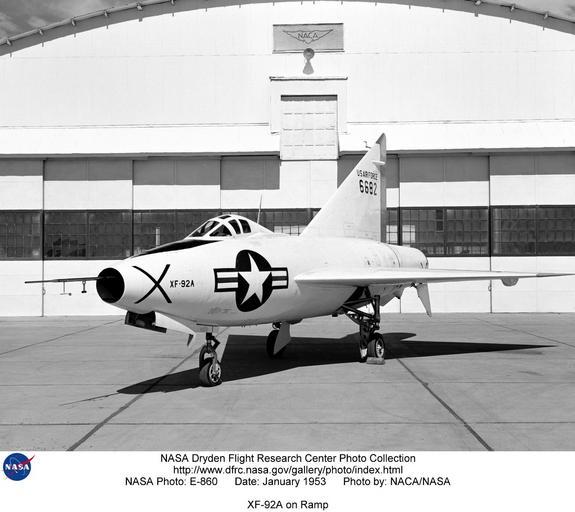MAKE A MEME
View Large Image

| View Original: | XF-92A_on_Ramp_DVIDS682911.jpg (1536x1367) | |||
| Download: | Original | Medium | Small | Thumb |
| Courtesy of: | commons.wikimedia.org | More Like This | ||
| Keywords: XF-92A on Ramp DVIDS682911.jpg en This NACA High-Speed Flight Research Station photograph of the XF-92A was taken at the South Base of Edwards Air Force Base The photograph shows the pitot-static probe used to measure airspeed Mach number and altitude mounted on a noseboom protruding from the aircraft's nose engine inlet Also attached to the pitot-static-probe portion of the noseboom are flow direction vanes for sensing the aircraft's angles of attack and sideslip The Convair XF-92A aircraft was powered by a Allison J33-A turbojet engine with an afterburner and was unique in having America's first delta wing The delta wing's large area thin airfoil cross section low weight and structural strength made this design a promising combination for a supersonic airplane The Consolidated Vultee Aircraft Corporation Convair XF-92A Dart was America's first delta wing aircraft It was built as a test bed for a proposed interceptor that never materialized The XF-92A was then continued to test the delta-wing concept The delta wing's large area 425 square feet thin airfoil cross section low weight and structural strength made a great combination for a supersonic aircraft The aircraft was powered by an Allison J33-A-29 turbojet engine with an afterburner Convair and the U S Air Force flew the XF-92A from 1948 to 1953 After the Air Force's plans for an interceptor failed to materialize the NACA High-Speed Flight Research Station which had supplied engineering instrumentation and operational assistance to the Air Force during its flights took over the flight test program in 1953 A Scott Crossfield flew all 25 NACA flights of the NACA's XF-92A program over a six-month test period The original XF-92A ship had a severe pitch-up problem but was tested with different wing-fence combinations to gather data on their contribution to solving that problem The pilot also reported that the aircraft was sluggish and underpowered Besides validating the thin delta wing principle the XF-92A played a major role in supporting the development of the Convair F-102A interceptor the Air Force's first attempt at an all-weather supersonic interceptor In 1953 the XF-92A experienced a landing gear failure on rollout after landing at the NACA High-Speed Research Station and the aircraft was retired The single-place XF-92A airplane had a delta wing swept at 60 degrees It was 48 2 feet long had a 31 3-foot wingspan and was 17 5 feet high at the tip of the vertical stabilizer It was controlled by a conventional rudder and full-span elevons that functioned as elevators and ailerons NASA Identifier NIX-E-860 2009-09-23 Glenn Research Center https //www dvidshub net/image/682911 682911 2012-10-10 10 38 WASHINGTON DC US PD-USGov Aircraft at Edwards Air Force Base Convair XF-92 Images from DoD uploaded by Fæ | ||||